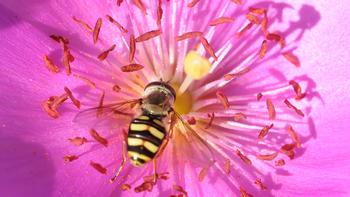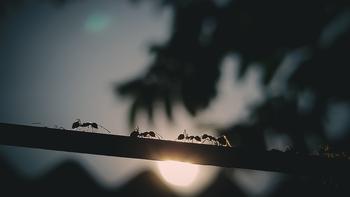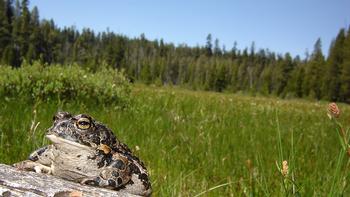Unsung environmental heroes
-
Marie Narlock
-
Bees, butterflies, and hummingbirds are the jocks, prom queens, and cheerleaders of the environmental world: everyone notices and adores them.
But what about the less alluring crowd?
The world is full of flying, crawling, slithering creatures that we hardly notice or that we consider bothersome. They aren't glitzy like iridescent hummingbirds or fluttering butterflies, but they are profoundly important.
Here are contributions of the environmental B-crowd: the annoying, scary, slimy, scaly things that help make life on Earth bountiful and healthy.
Let's start with the ubiquitous, annoying fly, of which there are 160,000 species. Flies pollinate over 100 crops, including cocoa for chocolate, pears, strawberries, apricots, blackberries, and many more. Kathy Keatley Garvey, UCANR
Flies pollinate over 100 crops, including cocoa for chocolate, pears, strawberries, apricots, blackberries, and many more. Kathy Keatley Garvey, UCANRThese admittedly irritating creatures pollinate over a hundred crops and are second only to bees as pollinating insects. Like chocolate? Thank the fly that pollinates cocoa flowers. Ditto the flies that pollinate pears, strawberries, apricots, blackberries, and more. Some flowers have even developed nasty-smelling flowers that mimic rotting meat to attract flies.
Flies are also part of nature's cleanup crew. Although it sounds unappetizing, flies lay eggs in rotting carcasses where the maggots eat the decomposing flesh. Then, as their digestive systems kick into gear, they release nutrients back into the soil. Pretty grotesque on the surface – yet imperative to a healthy environment.
Also vying for the category of most annoying pests are wasps. Here again, these flying carnivores have redeeming qualities, preying on aphids, caterpillars, and – wait for it – flies.
Parasitic wasps are particularly beneficial. These non-stinging insects are much smaller than the wasps and yellowjackets we avoid while barbequing. Parasitic wasps destroy aphids, mealybugs, whiteflies, and scale. But they don't eat them. Like something out of a Stephen King film, they turn them into mummies.
Female parasitic wasps lay eggs inside aphids. The egg hatches and the larva snacks on the aphid's tissue before secreting a chemical that turns the aphid into a mummified brown shell. The larva continues developing inside the mummy until it chews through the shell to create an exit hole. The adult parasitic wasp emerges, mates, and looks for new hosts. All this happens in two to three-weeks.
What about the lowly ant? Could something that tiny possibly contribute? Ants loosen the soil, increasing the availability of air and water underground and brings pebbles & particles aboveground. Prabir Kashyap, unsplash
Ants loosen the soil, increasing the availability of air and water underground and brings pebbles & particles aboveground. Prabir Kashyap, unsplashThe answer is yes. Ants are essential workmen, janitors, and engineers.
They move about the same amount of soil as earthworms. This loosens and tills the soil, increasing the availability of air and water underground and bringing pebbles and particles aboveground. Ants also help decompose dead insects, plants, and animals.
For you mathematicians, there are an estimated one quadrillion ants on Earth. That's a one with fifteen zeroes.
Even mosquitoes are pollinators. Believe it or not, their primary food source is flower nectar, not blood. (Only the females seek blood. Male mosquitoes never bite.)
Fortunately, another B-lister, bats, help keep mosquitoes in check. Although many consider bats scary, they're actually extraordinary exterminators. One brown bat can consume a thousand mosquitoes in an hour and a nursing mother devours her body weight each night.
And let's not forget the important stuff: bats pollinate agave, which gives us tequila, which gives us margaritas.
Frogs and toads also eat mosquitoes. Toads hide during the day and emerge at dusk to also eat flies, spiders, and snails. The average toad eats 50 to 100 insects every night. Salamanders chow down on beetles, mites, and woodlice. Toads hide in the day and emerge at dusk to eat mosquitoes, flies, spiders, and snails. The average toad eats 50-100 insects a night. R. Grasso, UCANR
Toads hide in the day and emerge at dusk to eat mosquitoes, flies, spiders, and snails. The average toad eats 50-100 insects a night. R. Grasso, UCANRAmphibians aren't beauty queens: salamanders are slimy, frogs are slick, and toads are warty and bumpy. However, finding one in your garden is a key indicator of environmental health.
No list of underappreciated garden visitors is complete without the dreaded, scream-inducing snake and lizard. Except for rattlers, Marin's snakes are harmless – and they eat slugs, grubs, mice, voles, rats, and gophers.
Lizards also eat insects and they possess a fascinating creature-feature ability to detach their tails when threatened (and grow it back later). The offloaded tail becomes a decoy, continuing to wiggle while the wise lizard escapes predators.
Hummingbirds may look pretty, but even they can't pull off that trick.



